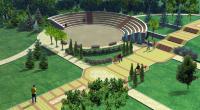
Pocket Park 2015
Summary
At long last, the final details concerning the design of my entry have been solidified, thoroughly examined, and polished. All of the concepts prior to the rhetorical park's conception have been adequately integrated: Apply a buffer zone, fix the park's troubled method of mobilization, make sure all of the seating (including benches) can view the recreational zone at all times, add greenery that was lacking, allow handicapped visitors to successfully enter the park without difficulty, and finally sculpt recreational structures that bear transcendental qualities. Trash cans have been added near the gazebo since that's where most of the trash is likely to be dispensed (also a recycling bin!). A bike rack has been rooted to allow visitors who plan on staying for awhile safely secure their bicycles. Instead of uprooting the trees that have been previously deployed, I decided not to agitate the already disturbed land and opted instead to design alongside them, and plant an additional two trees as well. "Antelope Hills Park" is designed for children twelve and under, but because of the park's broadened design, it can handle those who are aged above.
Now to take a step back and disclose my experiences towards the process of designing my entry, on a more human level: Many sleepless nights I have spent working rigorously away researching and supplying facts that, in the end, have consolidated a solid entry. I cannot recall the number of hours spent listening to the likes of Mazzy Star, Depeche Mode, The Smiths, Chris Isaak and numerous others while developing my site in Sketchup. The journey was long, but very, very fun.
Before I had the pleasure of entering this year's competition, I questioned pursuing the field of architecture; does it provide the creative outlet I so desire? Would I most importantly enjoy having a career associated with the designing of buildings? I purchased a book titled, "Becoming an Architect", by Lee W. Waldrep. This is where I first caught wind of the Chicago Architecture Foundation and its hosting of competitions suited for high school students. Immediately I was enticed, and so in an effort to expose myself to a different aspect of architecture other than just reading about it, I signed up. I learned that the more time you invest towards a design, the better the product. I have never been so unprecedentedly passionate about any project of mine until now. I learned that the steps of pre-conceptualizing a design is among the most important of phases. To draw, study, and focus so much on one particular site and its surroundings, I believe, gives insight towards the importance of a setting, and how it can become much more than a compilation of materials. In the end, I learned that architecture is more than the developing of shelters, it is the harvesting of cultural embodiment and the creation of landscapes precious memories are grown in. Thus, I learned that I wish to pursue a career in the architectural discipline.
This Step

What should I upload in the Final Design step?
- final hand or digital renderings
- images of your finished physical model
- or your finished digital model
You can even include links to a YouTube or Vimeo of a digital walk-through like this one: https://youtu.be/ncaVQ2V6XXU

Adaptive Reuse
Architects often find creative ways to reuse old structures that are no longer in use. Check out how old rail lines were adapted to create New York's High Line and Chicago's 606.






